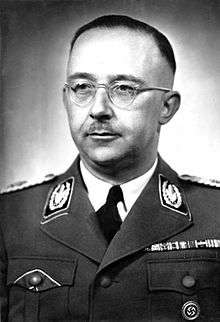Hugo Blaschke
| Hugo Blaschke | |
|---|---|
| Born |
14 November 1881 Neustadt in West Prussia, German Empire |
| Died |
6 December 1959 (aged 78) Nuremberg, Bavaria, West Germany |
| Occupation | Dental surgeon |
| Employer | Adolf Hitler |
| Known for | Service as Adolf Hitler's personal dentist. |
Dr. Hugo Johannes Blaschke (14 November 1881 – 6 December 1959) was a German dental surgeon notable for being Adolf Hitler’s personal dentist from 1933 to April 1945 and for being the chief dentist on the staff of Heinrich Himmler.
Life
Blaschke was born in Neustadt in West Prussia (now Wejherowo) and studied dentistry in Berlin and at the University of Pennsylvania.[1] He trained as a dental surgeon in London and opened his own practice in late 1911. During World War I, he served as a military dentist in Frankfurt/Oder and in Berlin. After the war ended, he went back to private practice in Berlin.[1] After treating Hermann Göring in 1930, he joined the Nazi Party on 1 February 1931.[1] He joined the SS on 1 May 1935.[1] As well as Hitler, he also treated Eva Braun,[2] Joseph Goebbels and Heinrich Himmler. Blaschke was promoted to the rank of SS-Brigadeführer on 9 November 1944.[1] He was also awarded the War Merit Cross with Swords, 1st and 2nd class.
In 1945, as the end of the Third Reich drew near, Blaschke accompanied Hitler to the Reich Chancellery and later the Führerbunker in Berlin. As the Red Army closed in on Berlin, Hitler on 20 April ordered Blaschke, Albert Bormann, Admiral Karl-Jesko von Puttkamer, Dr. Theodor Morell, secretaries Johanna Wolf, Christa Schroeder, and several others to leave Berlin by aircraft for the Obersalzberg. The group flew out of Berlin on different flights by aircraft of the Fliegerstaffel des Führers over the following three days.[3] Blaschke's long time dental assistant Käthe Heusermann had been offered a chance to fly out of Berlin with the others, but had declined and stayed behind with Hitler.[4]
Post-war
In early May, Soviet Red Army soldiers captured both Heusermann and Blaschke's long time technician Fritz Echtmann.[5] By 11 May the Soviets confirmed through Blaschke, Heusermann and Echtmann that a dental bridge and lower jaw bone found were Hitler's, and another dental bridge was Braun's.[2][6] Heusermann went on to spend the next ten years in a Soviet prison and was released in June 1955.[7] Echtmann, also spent several years in Soviet prisons until being released in December 1953.[8]
While in Austria, Blaschke was arrested by US Army forces on 20 May 1945.[5] He was interrogated by the Americans after the war about Hitler’s dental treatment in the hope that this would lead to the identification of his remains. Blaschke stated that he had been called in to examine Hitler in October 1944. He discovered that Hitler had a substantial gum infection in tooth number 6, which formed part of the fitted large dental bridge Blaschke had made for him in 1933, and Hitler wanted it to be dealt with quickly.[9] Blaschke went on to recount that he carried out surgery to cut off part of the bridge and remove tooth number 6 due to the infection causing the severe toothache.[9]
After his release from captivity in December 1948, Blaschke continued to practice as a dentist in Nuremberg. Blaschke reconstructed the dental records of Martin Bormann from memory, and these were later used to identify his skeletal remains, which were discovered in Berlin in 1972.[10] Hugo Blaschke died in Nuremberg at age 78 in 1959.[1] He is buried in St. Peter Cemetery in Nuremberg, but the gravestone stood till 1977 and the gravesite is since 1980 occupied by the family Gossler.
References
Citations
- 1 2 3 4 5 6 Joachimsthaler 1999, p. 297.
- 1 2 Kershaw 2008, p. 958.
- ↑ Joachimsthaler 1999, p. 98.
- ↑ Joachimsthaler 1999, p. 99.
- 1 2 Joachimsthaler 1999, p. 226.
- ↑ Eberle & Uhl 2005, p. 282.
- ↑ Joachimsthaler 1999, pp. 99, 299.
- ↑ Joachimsthaler 1999, pp. 207, 303.
- 1 2 Joachimsthaler 1999, p. 69.
- ↑ Lang 1979, p. 432.
Bibliography
- Eberle, Henrik; Uhl, Matthias, eds. (2005). The Hitler Book: The Secret Dossier Prepared for Stalin from the Interrogations of Hitler's Personal Aides. New York: Public Affairs. ISBN 978-1-58648-366-1.
- Joachimsthaler, Anton (1999) [1995]. The Last Days of Hitler: The Legends, The Evidence, The Truth. Brockhampton Press. ISBN 1-86019-902-X.
- Kershaw, Ian (2008). Hitler: A Biography. New York: W. W. Norton & Company. ISBN 978-0-393-06757-6.
- Lang, Jochen von (1979). The Secretary. Martin Bormann: The Man Who Manipulated Hitler. New York: Random House. ISBN 978-0-394-50321-9.
External links
- Dental detective work gets to the root of Hitler mystery
- Story of three SS dentists during World War II: Pr Hugo Blaschke, Dr Hermann Pook and Dr Willy Frank
- Mail Online article on 'Dentist of the Devil' by Menevse Deprem-Hennen

.svg.png)